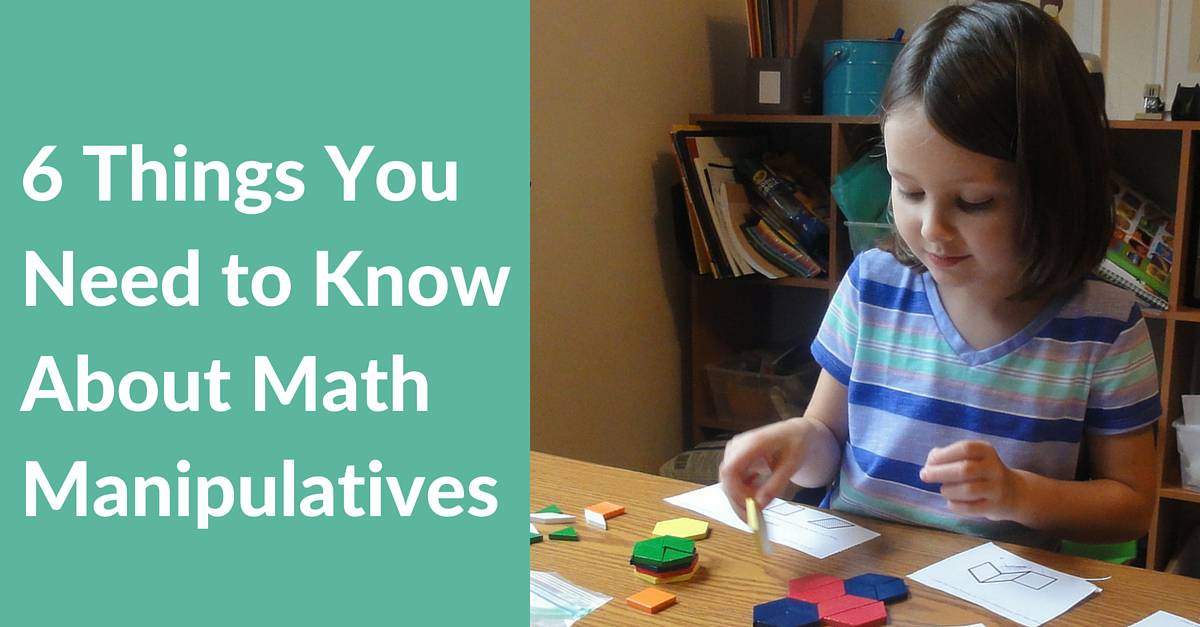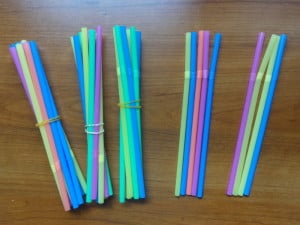 Ever wonder what exactly to do with all the math manipulatives that came with your math curriculum? Or wonder if using more manipulatives would help your kids understand math better? In this article, you’ll learn six facts about math manipulatives so you can use them effectively and confidently with your kids.
Ever wonder what exactly to do with all the math manipulatives that came with your math curriculum? Or wonder if using more manipulatives would help your kids understand math better? In this article, you’ll learn six facts about math manipulatives so you can use them effectively and confidently with your kids.
What are math manipulatives?
Just like the name suggests, math manipulatives are things that your kids can manipulate: stuff they can touch, move, and handle to help them understand math.
You probably have some objects from each of these categories around your house:
- Counters: tiles, counting bears, Unifix cubes, dry beans, popsicle sticks
- Place-value materials: abacus, base-ten blocks, Cuisenaire rods, bundles of straws, play money
- Geometry and spatial reasoning: tangrams, pattern blocks, geoboards
- Measuring tools: rules, protractors, geared clocks, scales, measuring cups
1. They’re not a fad.
I only remember pencil-and-paper math in from my public school days in the 80s and 90s. So when I began my teacher training, I assumed that math manipulatives were a new-fangled innovation.
But, I was wrong. People have been using hands-on stuff to teach math for centuries. Even teacher’s manuals for one-room schoolhouses in the 1800s suggested using real things to help children make sense of numbers.
“Begin the teaching of arithmetic, then, with objects,–blocks, balls, marbles, sticks, books, kernels of corn, apples, shells, pebbles, etc., etc. The more varied your assortment of objects, the better.” (The Eclectic Manual of Methods, p. 108, published in 1885)
Charlotte Mason (writing in 1886) also suggested that teachers use concrete materials as they introduce arithmetic to children:
“A bag of beans, counters, or buttons should be used in all the early arithmetic lessons.” (p. 256 in Home Education)
2. Younger children need more manipulatives.
Little children are very concrete learners. They can reason about real objects, but they have trouble thinking abstractly about numbers.
My 5-year-old is very much in this concrete stage right now. If I show her 5 blocks and ask how many will be left if I take away 2, she knows that 3 blocks will be left. But if I write 5 – 2, she immediately gets confused and frustrated. No matter how much I explain what the minus symbol means, her brain just isn’t ready to handle it.
Once children are about 10, they learn to reason more abstractly, and so they start to need fewer manipulatives. (But don’t hesitate to pull them out when your older child is grappling with a new concept for the first time.)
No matter how old your children, always remember that manipulatives are there to serve a purpose. Gradually encourage your children to visualize the manipulatives and use the manipulatives less until they no longer need them.
3. For the sake of your sanity: explore, then teach.
Any time you first introduce your child to a new manipulative, make sure you allow some free play and exploration time before trying to teach a focused lesson. Otherwise, you’ll spend the whole lesson trying to get your child to stop arranging the plastic teddy bears for a tea party or building a Jenga-style tower out of the Cuisenaire rods.
4. Add variety.
It’s fine to keep manipulatives simple, but try to use more than one manipulative for each new concept. This will help your child understand the new concept more deeply and apply it more flexibly.
For example, when you introduce fractions to your third-grader, you might start with circles cut into wedges. But don’t stop there! Draw rectangles and cut them into pieces. Mark fractions on strips of paper. Create groups of objects and find fractions of the group. Using all of these different models will help your child understand fractions deeply and apply them to a variety of real-life situations—not just pizzas and pies.

5. Kids don’t learn math because they use manipulatives; they learn because they think about the manipulatives.
Simply demonstrating a concept with manipulatives doesn’t guarantee that a child will understand the concept. For manipulatives to be effective, kids need time to think about what the manipulatives show.
One of the best ways to help your kids think about manipulatives to ask lots of questions as you teach. “How do you know?” is an especially powerful question. It allows you to check that your child really understands the concept and isn’t just guessing or following a pattern that he doesn’t really understand.
For example, let’s say you’re using bundles of straws to teach place value.

You might ask:
- How many straws are there? 39
- How can you tell without counting every straw one-by-one? There are three bundles of ten straws, so that’s thirty. There are nine loose straws, so that’s nine more. So, there are 39.
- If I took a straw away, how many would there be? 38
- If I took a bundle of straws away, how many would there be? 29
- If I added a straw, how many would there be? 40
- If I added a bundle of straws, how many would there be? 49
- How could you use dimes and pennies to show the same number of cents? How are the dimes like the bundles? How are the pennies like the loose straws? I could use 3 dimes and 9 pennies. The dimes are each worth ten cents, just like each bundle has ten straws. The pennies are each worth one cent, just like each loose straw is one straw.
6. Manipulatives don’t have to be expensive.
If your math curriculum calls for particular manipulatives, you’ll find teaching easier if you buy the suggested items. But manipulatives do not need to be expensive—or even store-bought. Free, everyday items are just fine for teaching math well.
Those nineteenth century one-room schoolhouse teachers were able to teach math well with beans, buttons, and pebbles, and you can, too!
Happy Math!



Thank you,
This concept is a great learning tool coupled with your suggestions on manipulating addition and subtraction concepts between objects and money.
Awesome!! Thank you for this resource.
First time homeschooler planning out next year’s curriculum! This is amazingly helpful; thank you so much for sharing!
Glad you found it helpful, Lisa!
Thank you, this is great! I also want to get 2 rolls of newly minted pennies so they aren’t dirty. Last time I was at the bank they didn’t have any.